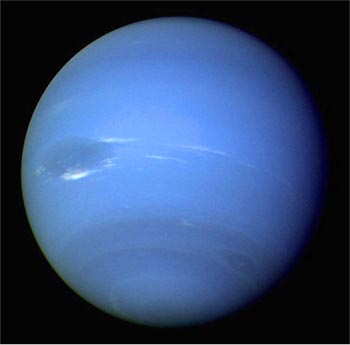8.2: Planet Neptune
- Page ID
- 244280
\( \newcommand{\vecs}[1]{\overset { \scriptstyle \rightharpoonup} {\mathbf{#1}} } \) \( \newcommand{\vecd}[1]{\overset{-\!-\!\rightharpoonup}{\vphantom{a}\smash {#1}}} \)\(\newcommand{\id}{\mathrm{id}}\) \( \newcommand{\Span}{\mathrm{span}}\) \( \newcommand{\kernel}{\mathrm{null}\,}\) \( \newcommand{\range}{\mathrm{range}\,}\) \( \newcommand{\RealPart}{\mathrm{Re}}\) \( \newcommand{\ImaginaryPart}{\mathrm{Im}}\) \( \newcommand{\Argument}{\mathrm{Arg}}\) \( \newcommand{\norm}[1]{\| #1 \|}\) \( \newcommand{\inner}[2]{\langle #1, #2 \rangle}\) \( \newcommand{\Span}{\mathrm{span}}\) \(\newcommand{\id}{\mathrm{id}}\) \( \newcommand{\Span}{\mathrm{span}}\) \( \newcommand{\kernel}{\mathrm{null}\,}\) \( \newcommand{\range}{\mathrm{range}\,}\) \( \newcommand{\RealPart}{\mathrm{Re}}\) \( \newcommand{\ImaginaryPart}{\mathrm{Im}}\) \( \newcommand{\Argument}{\mathrm{Arg}}\) \( \newcommand{\norm}[1]{\| #1 \|}\) \( \newcommand{\inner}[2]{\langle #1, #2 \rangle}\) \( \newcommand{\Span}{\mathrm{span}}\)\(\newcommand{\AA}{\unicode[.8,0]{x212B}}\)
Neptune was the first planet discovered through mathematical prediction. Urbain Le Verrier and John Couch Adams predicted the position in 1846. Neptune is smaller than Uranus, but denser. Like Uranus, Neptune is also referred to as an Ice Giant, as well as Uranus’ twin. It too may have a very small rocky core.Neptune also exhibits more atmospheric activity than Uranus. Its Great Dark Spot is a storm similar to Jupiter’s Great Red Spot, and about the same size as Earth. Neptune also has atmospheric scooters that are white cloud groups. It was so named because it moved faster than the Great Dark Spot. Its atmosphere sustains the highest winds in the solar system, in excess of 1,200 miles per hour. Like the other Gas Giant planets, Neptune also exhibits aurora activity.
Neptune has five rings, which are composed of dark particles. The rings appear to be broken, more like arcs or ringlets. There are 14 known moons (as of August 2014).
Neptune at a Glance
Characteristics to Compare
Atmosphere
- Rotation
- Revolution
- Rings
- Magnetic Field
- Neptune Satellite of Distinction — Triton (NOT to be confused with Saturn’s moon of the same name); Retrograde (captured moon?), volcanism; polar caps.
 Neptune, showing the Great Dark Spot and ScootersPublic Domain | Image courtesy of NASA.
Neptune, showing the Great Dark Spot and ScootersPublic Domain | Image courtesy of NASA. Clouds in the upper atmosphere of NeptunePublic Domain | Image courtesy of NASA.
Clouds in the upper atmosphere of NeptunePublic Domain | Image courtesy of NASA. Neptune’s moon TritonPublic Domain | Image courtesy of NASA.
Neptune’s moon TritonPublic Domain | Image courtesy of NASA.
- Neptune Satellite of Distinction — Triton (NOT to be confused with Saturn’s moon of the same name); Retrograde (captured moon?), volcanism; polar caps.
- Magnetic Field
- Rings
- Revolution
CC licensed content, Original
- Provided by: Florida State College at Jacksonville. License: CC BY: Attribution

